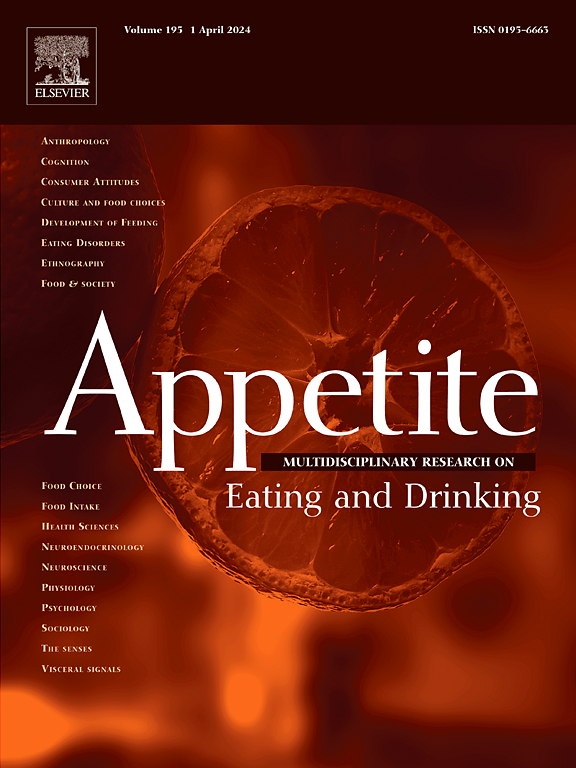Effects of overnight-fasted versus fed-state exercise on the components of energy balance and interstitial glucose across four days in healthy adults
IF 4.6
2区 医学
Q1 BEHAVIORAL SCIENCES
引用次数: 0
Abstract
Exercise is an essential component of body mass management interventions. Overnight-fasted exercise (FASTex) acutely enhances fat oxidation compared with fed exercise (FEDex). However, consistent FASTex training does not typically further enhance body mass loss, suggesting the induction of energy compensation responses. The present study aimed to test the effects of FASTex or FEDex on the components of energy balance (i.e., energy intake (EI), energy expenditure (EE), and appetite) and interstitial glucose metrics across four days.
Methods
Twelve (10 men, 2 women) healthy, physically active participants (age 22.6 + 1.2 years (mean ± SD); BMI 22.5 ± 2.8 kg ⋅ m−2) were studied twice, across four days, after a 75-min run either FASTex or FEDex. Daily EI was obtained after subtracting leftovers from the provided food. Daily fasting appetite was measured by visual analogue scales. Activity- and total- EE (AEE & TEE, respectively) were estimated by combining heart rate and accelerometry. Continuous glucose monitoring was used to capture daily interstitial glucose metrics and Likert scales were utilised to quantify fatigue, stress, sleep quality, and muscle soreness levels.
Results
No differences between conditions were observed for EI (FASTex = 15.0 ± 0.1 vs FEDex = 15.0 ± 0.4 MJ⋅day−1; p = 0.865), AEE (FASTex = 7.6 ± 1.1 vs FEDex 7.8 ± 1.3 MJ⋅day−1; p = 0.223) and TEE (FASTex = 15.9 ± 3.4 vs 14.9 ± 4.5 MJ⋅day−1; p = 0.136). Additionally, no condition effects for appetite (p > 0.05) and interstitial glucose (p = 0.074) were observed.
Conclusion
FASTex did not differ from FEDex in the response of components of energy balance or interstitial glucose across four days, suggesting that both exercise approaches could be used interchangeably.
隔夜空腹运动与进食状态运动对健康成年人四天内能量平衡成分和间质葡萄糖的影响。
运动是体重管理干预措施的重要组成部分。与进食运动(FEDex)相比,隔夜空腹运动(FASTex)能迅速增强脂肪氧化。然而,持续的 FASTex 训练通常不会进一步促进体质量的减少,这表明诱导了能量补偿反应。本研究旨在测试 FASTex 或 FEDex 在四天内对能量平衡成分(即能量摄入(EI)、能量消耗(EE)和食欲)和间质葡萄糖指标的影响:对 12 名(10 名男性,2 名女性)身体健康、运动量大的参与者(年龄 22.6 + 1.2 岁(平均 ± SD);体重指数 22.5 ± 2.8 kg ⋅ m-2)进行了为期四天的两次研究,研究时间均为 75 分钟的 FASTex 或 FEDex 跑步之后。从提供的食物中减去剩余食物后得出每日食欲指数。每日空腹食欲通过视觉模拟量表进行测量。活动 EE 和总 EE(分别为 AEE 和 TEE)通过结合心率和加速度测量进行估算。连续葡萄糖监测用于捕捉每日间质葡萄糖指标,李克特量表用于量化疲劳、压力、睡眠质量和肌肉酸痛程度:EI(FASTex = 15.0 ± 0.1 vs FEDex = 15.0 ± 0.4 MJ⋅day-1;p = 0.865)、AEE(FASTex = 7.6 ± 1.1 vs FEDex 7.8 ± 1.3 MJ⋅day-1;p = 0.223)和TEE(FASTex = 15.9 ± 3.4 vs 14.9 ± 4.5 MJ⋅day-1;p = 0.136)在不同条件下无差异。此外,没有观察到食欲(p > 0.05)和间质葡萄糖(p = 0.074)的条件效应:结论:FASTex 与 FEDex 在四天内能量平衡成分或血糖间质的反应方面没有差异,这表明这两种运动方法可以互换使用。
本文章由计算机程序翻译,如有差异,请以英文原文为准。
求助全文
约1分钟内获得全文
求助全文
来源期刊

Appetite
医学-行为科学
CiteScore
9.10
自引率
11.10%
发文量
566
审稿时长
13.4 weeks
期刊介绍:
Appetite is an international research journal specializing in cultural, social, psychological, sensory and physiological influences on the selection and intake of foods and drinks. It covers normal and disordered eating and drinking and welcomes studies of both human and non-human animal behaviour toward food. Appetite publishes research reports, reviews and commentaries. Thematic special issues appear regularly. From time to time the journal carries abstracts from professional meetings. Submissions to Appetite are expected to be based primarily on observations directly related to the selection and intake of foods and drinks; papers that are primarily focused on topics such as nutrition or obesity will not be considered unless they specifically make a novel scientific contribution to the understanding of appetite in line with the journal's aims and scope.
 求助内容:
求助内容: 应助结果提醒方式:
应助结果提醒方式:


